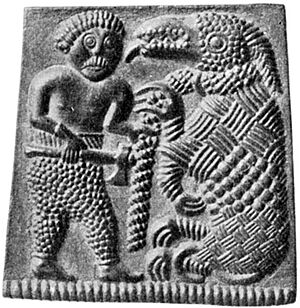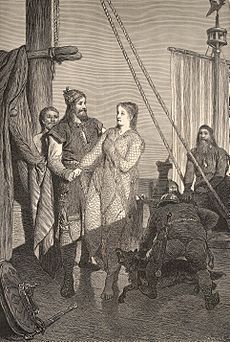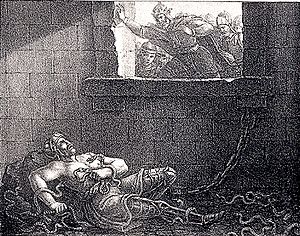Ragnar Lodbrok facts for kids
Ragnar Lodbrok, whose name means "Ragnar hairy-breeches," was a famous Viking hero and a legendary king of Sweden and Denmark. He is known from old Norse poems, Icelandic stories called sagas, and historical records from his time. According to these traditional tales, Ragnar became famous for leading many raids against the British Isles and the Holy Roman Empire during the 800s.
In Norse legends, Ragnar Lodbrok is said to be the son of Sigurd Ring, a legendary king of the Swedes.
Contents
Stories About Ragnar
Icelandic Sagas
Many Icelandic sagas, which are long stories, say that Ragnar was the son of Sigurd Ring, the king of Sweden. These stories describe Ragnar as a very handsome and strong man.
Ragnar first became famous when he killed a giant snake that guarded the home of a princess named Thora Borgarhjort. He wore special, tough clothes to protect himself from the snake, and these clothes earned him his nickname, Lodbrok ("hairy-breeches"). He married Thora, and they had two sons, Erik and Agnar.
After Thora died, Ragnar met a beautiful and wise woman named Kráka in Norway. He married her, and they had several famous sons: Ivar the Boneless, Björn Ironside, Hvitserk, Ragnvald, and Sigurd Snake-in-the-Eye. Later, it was revealed that Kráka was actually Aslaug, the secret daughter of the famous hero Sigurd Fafnesbane.
As Ragnar's sons grew up and became great warriors, Ragnar wanted to achieve even more. He decided to conquer England with only two ships. However, he was defeated by the English forces and was thrown into a pit full of snakes, where he died. The sagas tell that his sons, especially Ivar the Boneless, led a huge Viking army called the Great Heathen Army to England around 866. They wanted to get revenge on King Ælla of Northumbria, who was said to have captured and killed Ragnar.
Danish Stories
The first Danish writings that mention Ragnar Lodbrok appeared around the 1100s and 1200s. One important writer, Saxo Grammaticus, wrote about Ragnar in his book Gesta Danorum.
Saxo's story says that Ragnar's father, Sigurd Ring, was a Norwegian prince. After Sigurd and his rival died, Ragnar became the king of Denmark. One of his first big actions was defeating the Swedish king Frö. A fierce shield-maiden named Ladgerda helped Ragnar in this battle. Ragnar married Ladgerda, and they had a son named Fridleif and two daughters.
Later, Ragnar left Ladgerda and married Thora Borgarhjort, just like in the Icelandic sagas. He had to kill two giant snakes to win her hand. With Thora, he had more sons, including Sigurd Snake-in-the-Eye, Björn Ironside, Agnar, and Ivar the Boneless. He also had another son, Ubbe, with a different woman.
Saxo's stories describe Ragnar leading many successful Viking raids across a huge area. He conquered parts of England, Scotland, and Norway. His sons were made rulers in these conquered lands. Eventually, Ragnar led a Viking fleet to England again. He was captured by King Ælla and thrown into a snake pit, just like in the Icelandic sagas.
Old Poems and Inscriptions
Besides the sagas, there are older poems that mention Ragnar and his family. The Ragnarsdrápa, from the 800s, praises a Ragnar, son of Sigurd. Another poem, Krakumal, is said to be Ragnar's death song, where he talks about his battles while dying in the snake pit.
There is also a runic inscription (writing carved in stone) on a burial mound called Maeshowe in Orkney, from the early 1100s. It says: "This howe was built a long time before Lodbrok's. Her sons, they were bold; scarcely ever were there such tall men of their hands." The phrase "her sons" has made some people wonder if Lodbrok was originally thought of as a woman, the mother of these famous sons.
Frankish Accounts
In 845, a Viking leader named "Reginherus" or Ragnar led a large Viking fleet to attack Paris, the capital of the West Frankish kingdom. This Ragnar is often thought to be the same person as the legendary Ragnar Lodbrok, but historians are not completely sure.
This Ragnar's Vikings raided the city of Rouen on their way to Paris. The Frankish king, Charles the Bald, gathered an army. Ragnar attacked and defeated part of the Frankish army. He captured 111 of their men and hanged them to honor the Norse god Odin. This was also meant to scare the remaining Frankish forces. Ragnar's fleet returned to his king, Horik I, but Ragnar soon died from a serious illness.
Anglo-Saxon and Irish Accounts
The Anglo-Saxon Chronicle, a historical record from England, mentions that in 878, the "brother of Hingwar and Healfden" (Ivar and Halfdan) led a Viking fleet to England. They fought a battle where the Vikings lost their king and many men. After the battle, the Saxons took a special banner called "Raven."
An early 12th-century text, the Annals of St Neots, adds to this story. It says that "the three sisters of Hingwar and Hubba, daughters of Lodebroch (Lodbrok), wove that flag and got it ready in one day." It also says that a live crow would appear on the flag if they were going to win, and it would hang motionless if they were going to lose. This is one of the earliest mentions of the legendary hero Ragnar Lodbrok.
Irish historical records from the 1100s also mention King Halfdan (who died in 877) as "mac Ragnaill," meaning "son of Ragnall" or "son of Ragnar." This strongly suggests that the father of Ivar and Halfdan was indeed named Ragnar or something similar.
Ragnar's Sons
The Great Heathen Army is said to have been led by Ragnar Lodbrok's sons. Their goal was to get revenge on King Ælla of Northumbria, who had supposedly killed their father by throwing him into a pit of venomous snakes.
Some of the most famous sons who led this army were:
- Ivar the Boneless: He was the main leader of the Great Heathen Army from 865 to 870.
- Halfdan Ragnarsson: He became the leader of the Great Heathen Army around 870 and led an invasion of Wessex.
- Björn Ironside: According to later sagas, he became King of Sweden and Uppsala.
- Hvitserk
- Sigurd Snake-in-the-Eye: He might be the same person as Sigfred, who was a king in Denmark.
These sons are known as real historical figures, even if some of the stories about them are legends.
Is Ragnar a Real Person?
While Ragnar's sons like Ivar the Boneless, Halfdan, Björn Ironside, Ubba, and Sigurd Snake-in-the-Eye are known to be real historical people, historians are divided about whether their father, Ragnar, was a single real person. Many experts today believe that most of the stories about him are fiction.
However, some scholars think that parts of Ragnar's story might be based on real events or real people. It's possible that the legends of Ragnar Lodbrok combine the actions of several different Viking leaders from the 800s into one famous hero.
The most important old sources that talk about Ragnar include:
- Gesta Danorum: A book from the 1100s by a Danish writer named Saxo Grammaticus.
- The Tale of Ragnar's Sons and The Tale of Ragnar Lodbrok: Icelandic sagas (long stories).
- Ragnarsdrápa and Krákumál: Old Norse poems.
Historians have tried to connect the legendary Ragnar to real Viking leaders like Reginherus (who attacked Paris in 845) or King Horik I of Denmark. But it's hard to match all the different stories and their timelines. Still, the idea of a Viking hero named Ragnar who caused a lot of trouble in Europe in the mid-800s and had many famous sons is a very strong and lasting legend. Some parts of this legend are supported by more reliable sources, like Irish historical records and the Anglo-Saxon Chronicle.
In Books and Movies
Ragnar Lodbrok is a popular character in many stories and shows:
- The 1958 movie The Vikings features Ragnar, played by Ernest Borgnine. In the movie, he is captured by King Ælla and thrown into a pit of wolves. His son, Einar, played by Kirk Douglas, seeks revenge.
- The TV series Vikings, which started in 2013, has Australian actor Travis Fimmel playing Ragnar as the main character for the first four seasons.
- The video game Assassin's Creed Valhalla (2020) shows Ragnar's children continuing to rule and explore England. Ragnar himself appears briefly in a flashback of his death.
See also
 In Spanish: Ragnar Lodbrok para niños
In Spanish: Ragnar Lodbrok para niños
- List of legendary kings of Denmark
- List of legendary kings of Sweden





